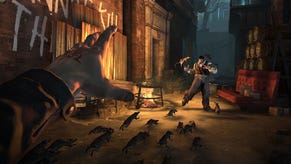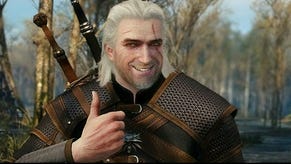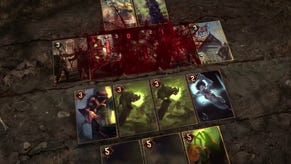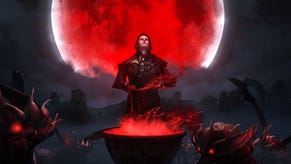How Gwent has evolved in its journey from minigame to multiplayer gem
Design changes detailed
Gwent [official site] is both one of the best PC minigames and one of its best collectible card games. Its first version, playable in The Witcher 3, is a smart minigame fantastically integrated into an RPG. Its free-to-play standalone version, which recently entered open beta, is a brilliant reinvention of the game for a multiplayer, competitive setting. Rather than opting merely to give a great minigame its own .exe, developers CD Projekt Red have clearly re-evaluated the rules from the ground up, radically altering Gwent so it works by itself. Gwent has retained its identity in the transition but it has also become a game that’s fun to play with other humans.
Gwent has evolved, and the continued existence of both versions provides a unique opportunity to ask how and why. Rarely do two games with the same structure and objectives exist side by side. It’s a terrific opportunity to investigate how Gwent has been adapted for its new purpose.
Gwent is a bidding game. Unlike most other recent card games, Gwent isn’t about knocking the other player out by reducing their life to zero. Instead you win by ending up with a higher total strength. Each match is played in a best of three format. You can only play one card per turn, but there are no restrictions on how powerful your card can be. It’s the same cost to play a unit with a strength value of ten as one. However, you don’t replace a card in your hand when you play a card. Rather, you begin the match with ten cards and draw two cards at the start of the second round and one in the third. At the end of each round, the board is cleared so your scores reset to zero.
Both sides of the Gwent board are divided into three rows, and each of your units can only be placed in the row marked on their card. In addition to a strength value, some cards have abilities which activate when you play them. In the minigame, Blue Stripes Commando doubles in strength when he’s placed beside another card with the same name. The Kaedweni Siege Expert boosts all units in the siege row excluding itself.
In both versions of Gwent, the result is a game in which players compete to win rounds with as few cards as possible. One of the most basic strategies is to bait the other player into playing a lot of cards when you play just a few. Even if they win a round they’re at a disadvantage thereafter. It’s a game which is less about deciding how you want to win as when you want to win.
In addition to a general pool of neutral cards anyone can add to their deck, both versions of the game have five factions. Each faction has access to its own set of cards, and in The Witcher 3 each faction has its own ability too. If you’re playing as Monsters, for instance, you get to keep one randomly selected unit at the end of the round. It’s often a good idea as a result to have just a few strong units, since one of them will increase your total not just in the current round, but in the round to come.
Gwent’s a great minigame but it’s worth saying too that it’s uniquely well intergrated into the wider world of The Witcher 3. While many of your possible opponents are anonymous innkeepers, merchants and travellers with no role except as Gwent opponents, The Witcher 3 also makes central characters play Gwent. One of the first unique opponents you meet, the Bloody Baron, is a key character in Velen who happens to enjoy Gwent. Get far enough in the story and you might find he’s unwilling or unable to continue playing with Geralt. Indeed, the Bloody Baron is given a little depth by his relationship to the game. Since he’s otherwise characterised as an impatient thug who rules through force, it’s a fun quirk of his character that he’s a Gwent enthusiast.
Characters are allowed opinions about Gwent, and consequently playing it feels like an activity Geralt is undertaking with the player rather than an incongruous distraction. Geralt himself obviously loves the game. People in Toussaint argue about whether the fifth faction, Skellige, is any good. Shani tells Geralt she plays Gwent because there’s nothing else to do in a soldier’s camp. Geralt’s friend Zoltan likes the game, but more importantly likes dealing in rare cards. Opponents in The Witcher 3 feel like people who happen to enjoy Gwent rather than people conjured for that purpose. Indeed, part of what makes Gwent intriguing to begin with is the infectious enthusiasm of Geralt and almost every other player. It’s hard to imagine anybody raving about Fallout: New Vegas’ Caravan in the same way.
The way in which Gwent and The Witcher 3 blend together is lovely in the context of a singleplayer RPG, but there are challenges attached to disentangling the two games. One way in which players are motivated to find and defeat powerful opponents in The Witcher 3 is to acquire their cards. Unfortunately, many of these cards are straightforwardly better than those you start out with: there’s very little reason to have a card with two strength and no ability when you could have a card with eight strength and no ability. If you’re playing most opponents you meet it’s not an issue, since the game is designed such that the first area has bad players with bad cards, while later areas have better players with better cards.
In multiplayer this would be obviously unthinkable. As such the most obvious change CD Projekt Red have made to standalone Gwent is to give every card some value. Obviously, some cards and even some factions are still considered bad (sorry, Northern Realms), but in theory at least every card has a use. Aside from fixing a glaring imbalance, this has the effect of making deck construction more interesting. There are, mercifully, no more choices that are simply mathematically better than other cards.
Cards still vary in strength and effectiveness, but if a card is weak it likely has an ability which makes it worthwhile. The Priestess of Freya only has one strength, but she’s also capable of resurrecting a card from the graveyard, key to many Skellige decks. The Mahakaman Defender, a card which merely had a power of five in The Witcher 3 now has an ability which allows him to stay on the field at the end of a round. As a result, it’s a card which encourages a style of play – probably you want to buff the Mahakaman Defender since it’ll stick around – rather than a merely bad card.
The less obvious problem with Gwent as implemented in The Witcher 3 is that it’s a solitary game. Yes, there are unit abilities and spells which affect your opponent’s board, but it’s also possible to go a whole round without doing more than placing cards and passing. You must keep an eye on your opponent’s total, but you don’t necessarily have to interact with him or her at all during the match. This problem is hardly noticeable against an AI, but as soon as you try to play the low interactivity version of Gwent with another human it becomes unbearable. Competing with other humans is the heart of all multiplayer games, so forcing players to play two parallel games would have made it dull.
Gwent solves this problem by vastly increasing the number of cards which change the state of the board. Triss Merigold has no effect in the Witcher 3, but she now removes five strength from an enemy card of your choice when you play her. Iorveth, who also had no ability, now removes four strength from an enemy when played, and damages all enemies who change rows by two. Beyond these changes to damage, standalone Gwent also introduces a raft of new mechanics which force players to interact with one another.
One of the keys to success as Nilfgaard, for instance, is careful management of ‘reveal’ cards. These cards allow you to make a card in either hand permanently visible. There are obvious advantages to revealing your opponent’s hand, but you’ve also got cards which benefit from being revealed. The Daerlan Foot Soldier gets placed on the board when he’s revealed, plus you get to draw a card. The Fire Scorpion damages a random enemy by three when it’s revealed.
There have always been spy cards which could be placed on your opponent’s board in Gwent, but in the standalone version they’re both more interesting and more plentiful. In keeping with Skellige’s graveyard theme, Birna Bran allows you to steal a unit from your opponent’s graveyard. She’s also placed on your opponent’s side of the board, where she damages herself and adjacent units. Disloyal cards, the game’s name for cards who go on your opponent’s board, are a fixture of the Nilfgaard deck: the spy gives one of your units a +10 boost when played on your opponent’s side, the emissary lets you draw two cards and keep one. Fake Ciri continually increases in power for every round she’s on your opponent’s side of the board, but reverts to you when your opponent passes.
Gwent’s increased focus on giving cards interesting abilities as well as a strength value also solves the problem that the outcome of a game was too predictable in The Witcher 3. Often it would become apparent who would win after just a few cards so it paid to restart Gwent matches when your opponent was far ahead. Now, even basic cards can have dramatic effects and even if the opponent is leading, all is not lost.
If Gwent has become a game with more unpredictable matches, though, it’s also finally become one with predictable cards. Gwent in The Witcher 3 had an infuriating tendency towards card text which left room for doubt about what the card would do when played. For instance, you might have a card in The Witcher 3 like the Kaedweni Siege Expert who increased the strength of cards around him. It might be important to know, in that case, whether he was increasing their base strength or temporarily adding to the top of it. The only way to learn was trial. Similarly, when cards were played directly from the deck or graveyard it was inconsistent whether their abilities would trigger. Losing at something because the rules are unclear is about the worst sin a game can commit, and in a competitive multiplayer scenario it would’ve been agony.
Luckily, standalone Gwent has become consistent and clear, in contrast to the minigame. Cards have a series of keywords, and two cards with the same keywords will behave in the same way. Deathwish abilities trigger when a unit dies, and if a unit says it ‘boosts’ another, that means it increases its current power, not its base power. Cards like scorch, with the word destroy, move a card to the graveyard, while cards with banish remove a card from the game. This change also makes cards more readable. You’ll more quickly grasp three keywords you understand than three sentences squished into a text box.
Gwent, admittedly, still has more work to do in this area. Why does scorch, which destroys the highest value unit, destroy all cards with that value, given that in other contexts ties are resolved randomly? Would it be too much to ask for units to list the modifiers affecting their strength? Why can’t I always see the base strength of a card? Improperly explained effects and unclear cards are still, unfortunately, a feature of the game but the problem has been greatly reduced, and the game’s still in open beta.
Standalone Gwent succeeds at evolving the game into one which is suitable for multiplayer. It respects the spirit of the highly successful minigame – it’s still a bidding game at heart, after all – but refines most parts so it’s a slicker, worthwhile experience. It's a fairer game which also manages to keep the outcome in doubt. Importantly, it’s also a game designed with interactivity between players in mind. As such, it’s a stellar multiplayer game and a great iteration on a fun concept.
















